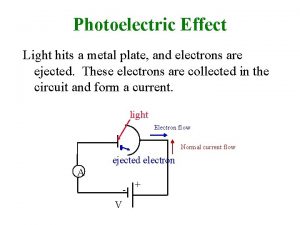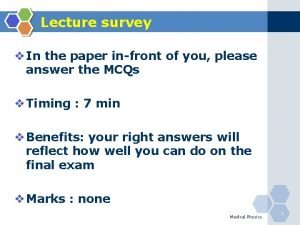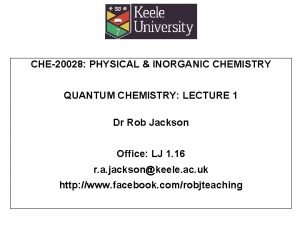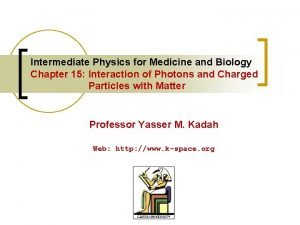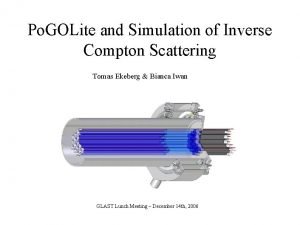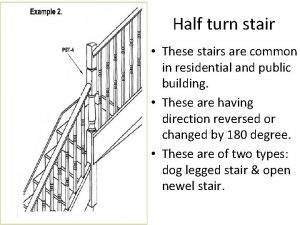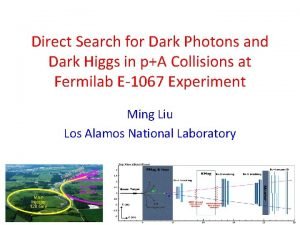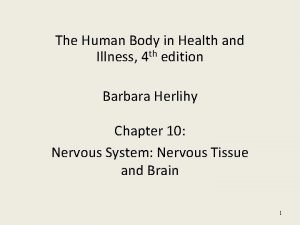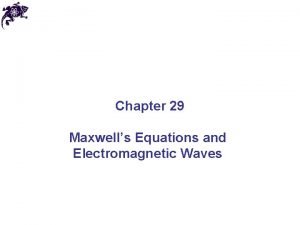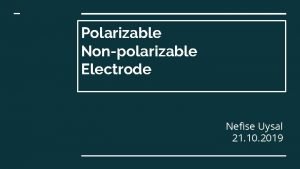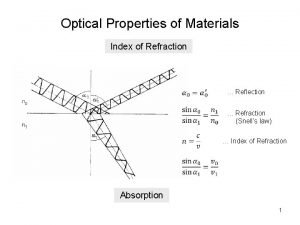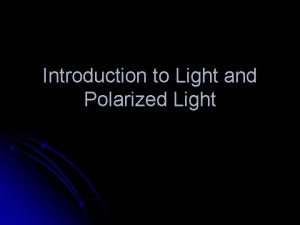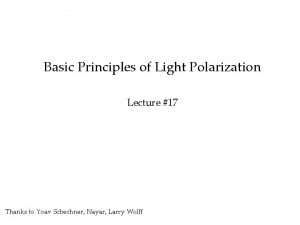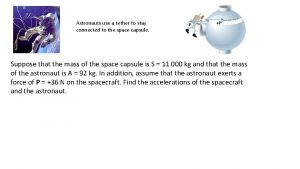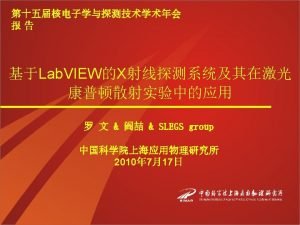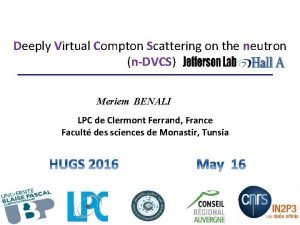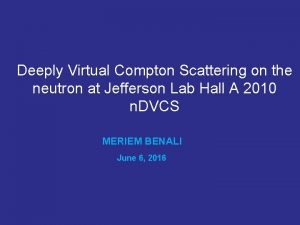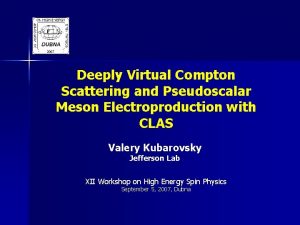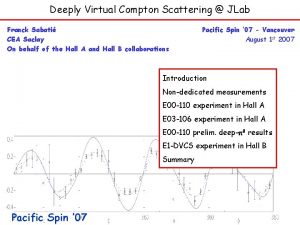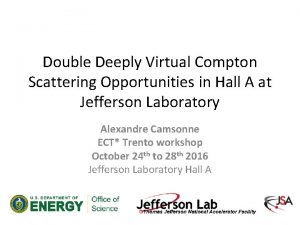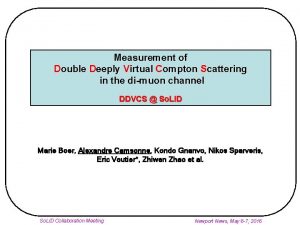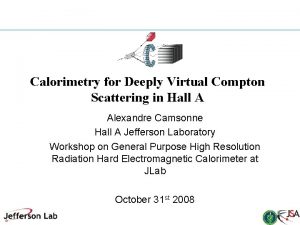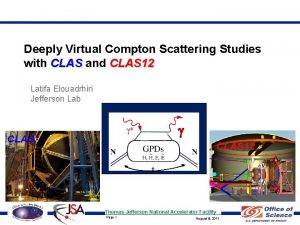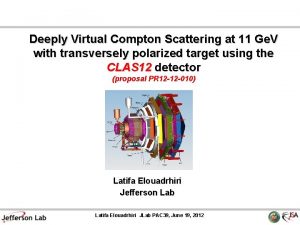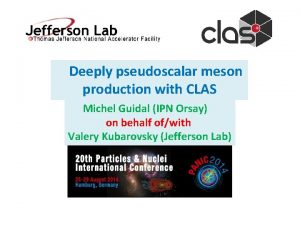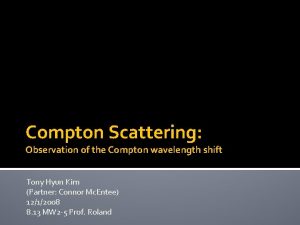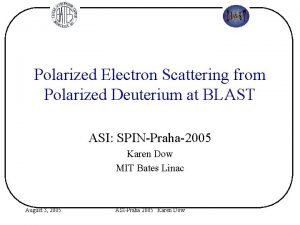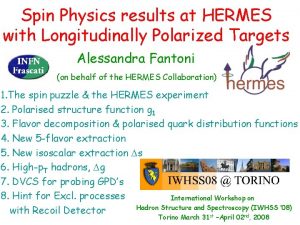Deeply virtual Compton scattering on longitudinally polarized protons
















- Slides: 16

Deeply virtual Compton scattering on longitudinally polarized protons and neutrons at CLAS k’ q’ k N GPDs N’ Silvia Niccolai, IPN Orsay, for the CLAS Collaboration QNP 2012, Palaiseau, April 19 th 2012

Deeply Virtual Compton Scattering and GPDs • Q 2= - (e-e’)2 • x. B = Q 2/2 M =Ee-Ee’ e’ g t e g. L* (Q 2) x+ξ • x+ξ, x-ξ longitudinal momentum fractions • t = (p-p’)2 • x x. B/(2 -x. B) x-ξ ~ ~ H, H, E, E (x, ξ, t) 4 GPDs for each quark flavor p’ p conserve nucleon helicity « Handbag » factorization valid in the Bjorken regime: high Q 2 , (fixed x. B), t<<Q 2 Vector: H (x, ξ, t) Tensor: E (x, ξ, t) ~ Axial-Vector: H (x, ξ, t) ~ Pseudoscalar: E (x, ξ, t) flip nucleon helicity Quark angular momentum (Ji’s sum rule) 1 [ 1 1 q q x + , 0 ( x, x, 0) ( x , ) E J = - JG = xdx H ò 2 2 -1 q X. Ji, Phy. Rev. Lett. 78, 610(1997) ] « 3 D» quark/gluon image of the nucleon

Sensitivity to GPDs of DVCS spin observables g f e’ e x= x. B/(2 -x. B) k=-t/4 M 2 Polarized beam, unpolarized target: ~ -k. F 2 E}df Ds. LU ~ sinf Im{F 1 H + x(F 1+F 2)H Unpolarized beam, longitudinal target: Ds. UL ~ sinf. Im{F 1~ H+x(F 1+F 2)(H + x. B/2 E) –xk. F 2 ~ E+…}df Polarized beam, longitudinal target: Ds. LL ~ (A+Bcosf)Re{F 1~ H+x(F 1+F 2)(H + x. B/2 E)…}df Unpolarized beam, transverse target: Ds. UT ~ sinf. Im{k(F 2 H – F 1 E) + …. . }df leptonic plane hadronic plane Proton N’ Neutron ~, E } Im{Hp, H p p ~ Im{Hn, En} ~ Im{Hp, Hp} ~ Im{Hn, En} ~ Re{Hp, Hp} Re{H , E~} n Im{Hp, Ep} Im{Hn} n n

Sensitivity to GPDs of DVCS spin observables g f e’ e x= x. B/(2 -x. B) k=-t/4 M 2 Polarized beam, unpolarized target: ~ -k. F 2 E}df Ds. LU ~ sinf Im{F 1 H + x(F 1+F 2)H Unpolarized beam, longitudinal target: Ds. UL ~ sinf. Im{F 1~ H+x(F 1+F 2)(H + x. B/2 E) –xk. F 2 ~ E+…}df Polarized beam, longitudinal target: Ds. LL ~ (A+Bcosf)Re{F 1~ H+x(F 1+F 2)(H + x. B/2 E)…}df Unpolarized beam, transverse target: Ds. UT ~ sinf. Im{k(F 2 H – F 1 E) + …. . }df leptonic plane hadronic plane Proton N’ Neutron ~, E } Im{Hp, H p p ~ Im{Hn, En} ~ Im{Hp, Hp} ~ Im{Hn, En} ~ Re{Hp, Hp} Re{H , E~} n Im{Hp, Ep} Im{Hn} n n

What we have learned from the published CLAS asymmetries CLAS p. DVCS BSAs F. -X. Girod et al, PRL. 100 162002 (2008) Model-independent fit at fixed x. B, t, Q 2 of DVCS observables Im. H has steeper t-slope than ~ Im. H: is axial charge more concentrated than the electromagnetic charge? M. Guidal, Phys. Lett. B 689, 156 -162 (2010) CLAS p. DVCS TSAs eg 1 (2000), not a DVCSdedicated experiment S. Chen et al, PRL 97, 072002 (2006)

The eg 1 -dvcs experiment at CLAS • Data taken from February to September 2009 • Beam energies = 4. 735, 5. 764, 5. 892, 5. 967 Ge. V • Beam polarizaton ~ 85% • CLAS+IC to detect forward photons • Target: longitudinally polarized via DNP (5 Tesla, 1 Kelvin, 140 Ghz microwaves) NH 3 (~80%) and ND 3 (~30%) – Luminosity ~ 5∙ 1034 cm-2 s-1 • Target polarization monitored by NMR • ~75 fb-1 on NH 3 (parts A, B), ~25 fb-1 on ND 3 (part C) Polarized ammonia Carbon Empty cell C. D. Keith et al. , NIM A 501 (2003) 327

p. DVCS (ep→e’p’g): particle ID Energy deposited in EC for negative tracks Db (DC/TOF) for positive tracks p+ protons deuterons Electron ID cuts: Charge: -1 0. 2 < E/p < 0. 4 (energy deposited in EC) Ein > 0. 06 (energy deposited in inner EC) p > 0. 8 Nphe(CC)>2 Geometrical matching between EC, SC, CC z vertex cut EC, DC fiducial cuts IC photon ID cuts: E >2. 5 Ge. V Geometrical fiducial cuts Proton ID cuts: Charge > 0 z vertex cut ¦Δβ¦ < 0. 035 DC fiducial cuts EC photons not yet included in the analysis (<10% events)

p. DVCS: channel selection & coverage Kinematical and exclusivity cuts to select DVCS events: • Eγ>2. 5 Ge. V Q 2>1 Ge. V 2 W>2 Ge. V • Cone Angle (angle between detected and predicted γ) • MM 2 ep. X • Missing Energy • Coplanarity (angle between (γ*, p) and (γ, p) planes) • MM 2 epg. X • Missing Transverse Momentum (in reaction frame) Cone angle: before/after cuts

p. DVCS- Sanity check: Beam Spin Asymmetry eg 1 -dvcs F. -X. Girod et al, PRL. 100 162002 (2008) Integrated over all kinematics, only IC photons included Only eg 1 -dvcs part B data (~2/3) No p 0 background subtraction yet Beam polarization: ~ 83 %

p. DVCS: Target Spin Asymmetry Preliminary <x. B>~0. 3 <Q 2>=2. 3 (Ge. V/c 2)2 Dilution factor: f~ 0. 76 Target polarization: PT=-85%, +90% Only IC photons included only eg 1 -dvcs part B data No p 0 background subtraction yet Erin Seder, UConn Gary Smith, Glasgow

p. DVCS: Double (Beam-Target) Spin Asymmetry Gary Smith, Glasgow First bin in -t p 0 vs x. B ALL THESE RESULTS ARE VERY PRELIMINARY! Dilution factor: f~ 0. 76 Target polarization: PT=-85%, +90% Beam Polarizarion: PB= 83% Only IC photons included only eg 1 -dvcs part B data No p 0 background subtraction yet p 1 vs -t p 2 vs -t

DVCS on different targets Daria Sokhan, IPNO Free proton F. -X. Girod et al, PRL. 100 (2008) 162002 NH 3 H 2 n Free proton in nuclear medium Quasi-free proton in deuterium and in heavier nuclear medium Calculate DVCS on a “free” neutron ND 3 Quasi-free neutron in deuterium and in heavier nuclear medium

Sanity check: ALU – proton in NH 3/ND 3 Daria Sokhan, IPNO Raw beam-spin asymmetries No p 0 background subtraction Good agreement between the two analyses

n. DVCS in ND 3 – channel selection B < 0. 95 (EC timing) p. X Standard PID cuts for electron and photon Exclusivity cuts:

n. DVCS ALU beam-spin asymmetry from ND 3 Very preliminary Daria Sokhan, IPNO Projections for 90 days of running with CLAS 12 <x. B>~0. 3 <Q 2>=2. 3 (Ge. V/c 2)2 Integrated over all kinematics No p 0 subtraction yet Statistics very low, but ALU≠ 0! AUL analysis also underway More data will be taken with CLAS 12 at 11 Ge. V, on liquid deuterium target

Summary and outlook • Combining various DVCS spin observables for proton and neutron targets is necessary to provide constraints for model-independent extractions of Compton Form Factors (→GPDs) • The eg 1 -dvcs experiment combined the CLAS-DVCS setup (CLAS+IC) with polarized hydrogen and deuterium targets • Preliminary results for TSA for p. DVCS are in good agreement with existing data, and the statistics with respect to previous CLAS data has been improved by more than a factor 5 • Preliminary results for double-spin asymmetries show dominance of the constant term • Very preliminary results for n. DVCS (very low statistics) hint to non-zero beam-spin asymmetries • A lot of work (mainly on background subtraction) still needs done • Much more data for both p. DVCS and n. DVCS on a wider phase space will come from CLAS 12 Thanks again to Erin Seder, Gary Smith, Daria Sokhan
 Compton scattering
Compton scattering Compton scattering vs photoelectric effect
Compton scattering vs photoelectric effect Compton scattering
Compton scattering Compton effect
Compton effect Compton scattering
Compton scattering Open newel half turn stair
Open newel half turn stair Chapter 80 brake system technology answers key
Chapter 80 brake system technology answers key Polarized pluralist model
Polarized pluralist model Dark sector upgrades
Dark sector upgrades Homunculus
Homunculus Ampere maxwell law
Ampere maxwell law Ideal polarizable electrode
Ideal polarizable electrode Index of refraction formula
Index of refraction formula Light definition
Light definition Polarized wave
Polarized wave Suppose your car was mired deeply in the mud
Suppose your car was mired deeply in the mud Physical function of art
Physical function of art
